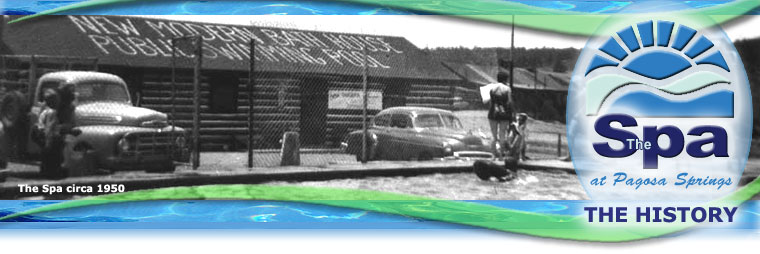|









|
|
Early Settlers' History of the Pagosa Hot Springs
During July of 1859, Captain John N. Macomb led a group of United States of America Topographical Engineers through the area and is probably the first white American to officially see and accurately describe the hot spring. These accounts attracted a trickle of white visitors whose presence the Utes tolerated in summertime but prohibited in winter, when the tribe gathered here. Macomb is quoted as saying: “There is scarcely a more beautiful place on the face of the earth.”
In 1873, the United States acquired the land from the Utes in the Brunôt Treaty, and settlers soon came to Pagosa Springs—first farmers, ranchers, and miners, then loggers beginning in the 1890s. But the springs themselves remained the town’s foundation.
In 1875, Major Foote made claim to the parcel of land and hot springs. In 1876, Dr. Frank Keebles made claim to the same parcel of land. Settlement was reached in favor of Major Foote. In 1876, Welch Nossaman settled in Pagosa only to be chased away by the Indians, and returned the next spring.
On May 22, 1877, an Executive Order of the President of the United States of America designated one square mile with the hot springs as the center of the square mile as a United States of America town site. It was platted in 1883 and in 1885 building lots were appraised and patents were sold to individuals under certificates numbered 1 to 733.
In 1881 Thomas Blair erected Pagosa’s first public bathhouse on the San Juan River bank near the Great Pagosa Hot Spring. A ditch carried water from the spring to the bathhouse. The bathhouse was a godsend to hardworking frontier folk, and pleasure seekers and convalescents have been drawn here ever since to soothe body and spirit in the ancient healing waters.
In the fall of 1878, construction began on Fort Lewis in Pagosa Springs to help control the Ute Indians, and on January 28, 1879 it received executive approval of President Rutherford B. Hayes. Fort Lewis served the purpose of controller and protector and is one of the main reasons Pagosa Springs survived to become an active community today. However; in 1879, the Meeker Massacre in northern Colorado prompted the Army to move to another site. A temporary garrison remained there until 1882 when the remaining site was known as Pagosa Springs.
On May 20, 1885, Archuleta County was created, named for the Archuleta family from Conejos County, covering 1,100 square miles. Pagosa Springs was incorporated in 1891 and became the county seat. Attention then returned to the hot spring itself as a possible health resort for people with all sorts of ills. Bathing in or drinking the mineral water has been said to cure everything from rheumatism to obesity.
Source: coloradohistory.org.
Top of Page
|
|
|
